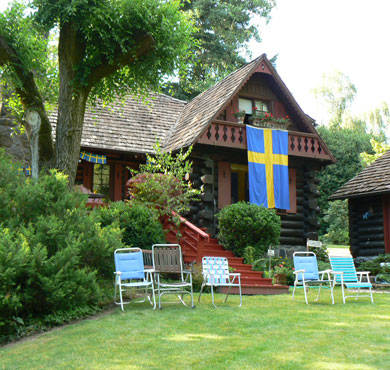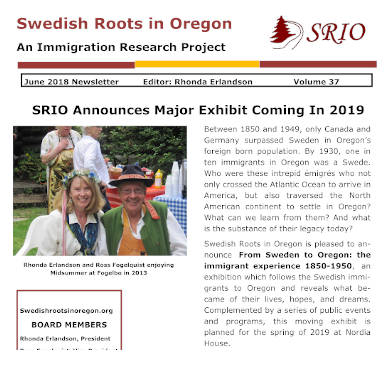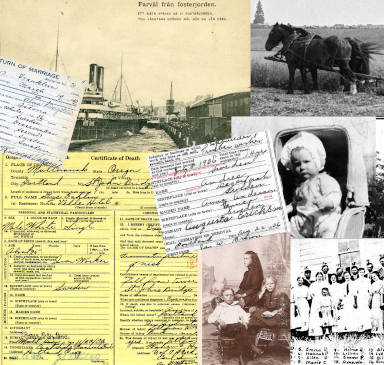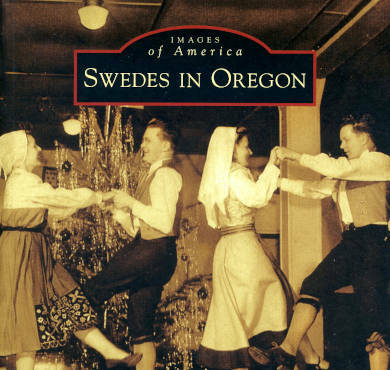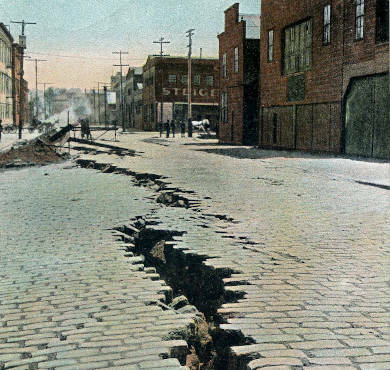An interview with one of Oregon’s better known women poets. Portland: Swedish Roots in Oregon, 2001, 28 p.
Introduction to Vi Gale: The Immigrant Story
Behind the Poetry
An interview with one of Oregon’s better known women poets.
Portland: Swedish Roots in Oregon, 2001, 28 p.
In 1923, when Erland Håkansson was 35 years old and his wife Maria was 31, they decided to do what so many Swedes had done before them: sell practically everything they owned and emigrate to the United States. Up until then they had lived with their two children, Viola, aged six, and Harry, two, in a small village in Dalarna called Noret, near Dala-Järna along Västerdalälven. The exodus followed the familar pattern of the more than one million emigrants before them: relatives driving them to the train station with a horse and carriage, train to Oslo, ship to New York, admission through Ellis Island, slightly modified names, and then a long train trip across the United States to a new life in the Swedish community in Clatskanie, Oregon. None of them spoke more than a handful of English words.
Life in Clatskanie was also a fairly typical immigrant acculturation experience: while the father worked as a logger among Scandinavians in the Oregon woods, the children went to school and did their utmost to get rid of whatever trace they had of their native language. As Vi says in the interview: “We did not get any points in those days for our ethnicity, I’ll tell you. If anything, it was something we were really heckled about. We wanted to leave it behind as quickly as possible.” During World War II, the entire family became US citizens, and Vi’s brother served in the US military. During the same time, Vi moved from Clatskanie to Portland, where she met, married and eventually settled with her husband James Gale.
Vi Gale began writing and publishing short stories and poems in the 1950s, and in 1974 she started the small publishing house Prescott Street Press. In the late 1970s when I first met her, and learned of her Swedish background, I became interested in the evolution of her writing career. I knew she only wrote in English and that she did not work actively as a translator, but why had that happened? Where did the Swedish fit in? Was Vi Gale an American author who had just happened to have been born in Sweden to Swedish parents, and who knew Swedish, but whose formative influences had been primarily American? Or should she somehow be considered a Swedish-American author? I knew that she had written poems about her Swedish childhood, and on subjects which could be considered Scandinavian, so there was at least a certain ethnic dimension to her work. In addition, even though I knew she had never returned to Sweden, I wanted to find out what kind of ties she had kept to Swedish culture and literature.
Curious about all this, I decided to interview Vi Gale about it, and what follows will, I hope, shed a little bit of light on some of the forces that have helped shape her almost fifty years of writing and publishing in Oregon.
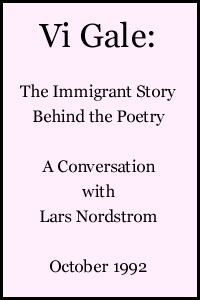
Excerpt from Vi Gale: The Immigrant Story Behind the Poetry
I left Clatskanie pretty much for good and came to Portland in 1940. I worked at almost anything, took some classes, and had some idea I was going to put myself through school. Then along came the war and in about 1942 I married Jim Gale! By that time the war had broken out and we began traveling. I traveled with him as long as I could until he went overseas. He was overseas about three years, first stationed in Paris, then Heidelberg, Germany. My brother Harry, of course, went in the army. Everybody I knew was in. My brother married a nurse, a first lieutenant in the nurse corps. He came back and went to Lewis & Clark College and became an engineer.
In the fall of ‘46 Jim was back and we moved in here–this house was new then–and I began taking writing classes at Portland State University and writing classes here and there.
Had you written before? When did you start writing?
I recall writing when I was quite young, if you call that writing. I was always very good in English composition, and I remember doing a poem that I can’t find now, to put into a scrap book for the children of Poland! It was all about birds flying in and out under the eaves, I remember that part. And the Clatskanie Chief, which was the town newspaper, used to give one page to the high school journalism class. What I know about journalism, I learned in high school down there, and I certainly wrote a lot for that page. The instruction I got in journalism there I am drawing on yet, which is very curious. I think it was our junior year in high school we had journalism as part of our English, and we had that one page, that Art Steele, who owned the paper, let us have each week. I really think the English and the grammar that I learned, and the diagramming and what have you, is superior to what they are getting now. I don’t know, maybe it was easier.
So if I understand your environment right, when you started writing, it was always English. Swedish was a passive language, something you could understand, but not actively engage in as a writer. English was your primary language.
Yes, in a way my second language became my first language! I could not write any Swedish really. I had to teach myself that, and I had to teach myself to read Swedish, which I have done by reading in books. I remember beginning to work in the library at a very early age, and they had two volumes there called The History of Sweden, and I remember reading that. It was in English, but full of Swedish references, and filled me in on things like Gustav II Adolf. When my father was home, and you can appreciate how little time he spent at home, he would tell us about Selma Lagerlöf and Carl von Linné, and I got some of it that way.
Did you read a lot?
Yes, I read a lot, but it was always in English until I got older and had taught myself to read Swedish. But I remember, oh little things–I guess it is Humpty Dumpty: “Lille Trille låg på hyllan, Lille Trille trilla ner, ingen doktor finns i detta land som Lille Trille laga kan” [an old riddle]. And “Gud som haver barnen kär, se till mig som liten är” [the opening line of a common child’s prayer]. Some of those things we knew, and at some time we had a blackboard in the kitchen, that my father had made, of course, and we learned to read the Swedish anthem off of that: “Du gamla du fria, du fjällhöga nord”. And sometimes Swedish hymns. My mother would sing a lot. I remember one time they bought me a guitar, and I think they bought it for my mother, because I can remember her sitting in that rocking chair strumming away singing about “Lejonet av Juda” [the “Lion of Judah”]. I thought, what in the world has that got to do with anything. And from her, I think, we learned passages out of the Swedish Bible, not to read, but to repeat or say.
But we really made an effort to get assimilated, and it was self-preservation really. Not until after World War II do I recall this turning around when some of the American GIs went overseas and learned to speak a little French. They came back with a phrase or two and were so proud. Well, you would have gotten massacred for speaking a foreign language before that. If there is a positive side to military service or to war, I think it is that it gets people out and around. You lose some of that terrible provincialism.
I know that you asked me if I felt that it was an enrichment to be bi-cultural, and I surely do. You see similarities and cross-overs, and it is just an enrichment to all of living. It pops up at the most astonishing times.
During the Depression, I should have tucked this in too, at one time they offered free deportation to people that wanted to go back. Times were so tough. I remember some Swedes who opted to go back, because they had families and people who looked after them. Then a lot of these men who came, like my mother’s nephews, were in their twenties and straight out of their homes. We were sort of a second home to them. I don’t know that times were any easier in Sweden, very likely they were not. Boy, there weren’t jobs anywhere when I first came to town. Women did not work the way they do now, you know. If a school teacher married she lost her job automatically in those days. There were fewer jobs for women, and mostly women did not work except in the service occupations or sales occupations, and the wages were not handsome. I remember working in coffee shops and hotel coffee shops and things like that because I got my meals there, and the uniforms and clothes were not what they were in the retail stores, where you really had to dress in those days. You’d come out with nothing. And I made more money than my friends who were teaching. Women could be teachers, but as I said, the minute they married that job was gone. It was supposed to go to the bread winner or somebody that really needed it. A woman was supposed to marry someone who would provide for her. She did not need to be self-supporting.
Let’s loop back to the advantages of being bi-cultural–I wanted to ask you if you pursued reading any particular Swedish authors?
Well, I read Selma Lagerlöf, of course, in the original, and I managed to read Ibsen in Norwegian. It has been a long, long time since I looked at them, but some of the poets I recall. I had Sten Selander’s Den Unga Lyriken out of the library I don’t know how many times, and I recall Harry Martinson, Gunnar Ekelöf, and Stig Dagerman, but haven’t for a long, long time gone back and read them. Then, for a while I took Bonniers Litterära Magasin, and of all things I read Swedish translations of Gary Snyder and the Beatniks there, that kind of thing. But not very much of the contemporary Swedish. If I read any poetry at all it was likely to be newspaper verse, or something like that, that my uncle had written.
My mother was a great fan of somebody called Zacharias Topelius, and someone came up with Esaias Tegnér, Frithiofs Saga, which I read. Somehow the contemporary Swedish poets were not the kind of thing I was getting introduced to then, and you have to recall, everybody in American poetry was writing very formally. This was before Allen Ginsberg, before Gary Snyder, and before the San Francisco uprising that really loosened up American poetry. I remember during the war, and I was not writing then, except any commercial thing, I was reading e.e. cummings and Marianne Moore, and those were totally foreign to anybody that I knew. But I happened to have a boyfriend at Reed College early on who introduced me to those, and those were considered very avant-garde then. Poetry magazine I read, but it was very formal in those days. And it was in 1957 or ‘58 that I sold two poems to Poetry magazine and I felt that I had made the team.
You once mentioned the Ernst Josephson show at the Portland Art Museum in January 1964. What was it like?
Interesting. Especially my exchanges with poet Erik Blomberg and Ingrid Mesterton, who were both there. I felt truly bi-cultural, in the good sense. Blomberg later sent me his book För Ljusets Skull and Mesterton told me of scholarly work including translations of poets like T.S Eliot. I wore my folkdräkt från Järna [Järna folk costume] and ladled glögg [mulled wine] to the crowd. The whole things was arranged by the museum’s director, Dr. Francis J. Newton, who had studied art in Sweden.
You referred to commercial writing earlier. Did you make a living doing that then?
Not really, but I pieced out our household income. I did a lot of price contesting and fillers for the paper and what have you. It was in about the 50’s that I began writing seriously, and somehow in my head I knew the difference. I began reading little magazines, the New Directions anthologies, I just knew that was where my niche was, because my interests and concerns were along that line. I just knew that was the kind of writing I was probably going to do if I was going to do it, and I made my last real money, I tell you.
But you started out writing prose, short stories…
Yes, I wrote short stories. I had about five published ones and a couple of unpublished ones too. They were published in reviews and little magazines. The first one went to the Stanford Spectator, out of Stanford University. I had it in galleys when I thought, well, I have some money saved, I’ll go to a writer’s conference. It was in 1955. I went to the University of Colorado in Boulder for a couple of weeks. And they were good enough to pick up my third week there too so I could stay on a scholarship. I was in my thirties then, and a little older than most scholarship kids would have been. Seems to me I was always older than everyone else. I met May Sarton there, who I really credit with taking an interest in my work. I remember May Sarton reading my story to the class. It was a big boost for my ego.
Lawrence Richard Holmes was there, and a bunch of Eastern writers, and that was very useful. But I think the most useful thing was meeting other people, and especially the scholarship kids who were there from the Columbia journalism school in Missouri, Sweet Briar and Wellsley, the kids who were really bright. Somehow Lawrence Richard Holmes had arranged for me to meet Alan Swallow. I was in the theater where he spoke that evening, and they waved to me and I waved back, but I misunderstood them. I didn’t know they wanted me to wait and meet him. Then later, when I got back to the dorm there was a note there from Alan Swallow. He had picked up one of my poems in a little, tiny literary magazine in Louisiana or something–imagine being that aware!
When I was about to catch the bus back to Portland from Denver, I could not make myself go to the phone and call Alan Swallow, I was so in awe of the literary establishment. Because remember, I was not an academic, had not been to college. So I went home and worked on a manuscript, a sheaf of poems, and May Sarton looked at them and wrote: “You are about two years from a book.” And that was just exactly what I was. In a year or so I submitted a manuscript to Alan Swallow and said: “We met one time, almost.” He remembered my work and began working with me. It was a profound influence and he certainly deserves a bigger place in American letters than he has had to date.
Alan Swallow is probably responsible for the kind of book I put out, the first one, Several Houses. Very formal, and the heads of all the lines are capped and so on and so forth. As a poet you became aware right away that you are not necessarily going to get into print what you might want done. You have an editor, and maybe they knew more than I did, I don’t know, and almost anybody would have at that stage. Anyway, he edited that book and it went very well and sold out, and he reprinted it. In fact, at one stage, they wanted to use it as a text at the University of Washington, and he put out a little paper back edition for 75 cents so that it could be easily purchased by students, and they sold 500 additional copies like hot butter up there. That was very gratifying.
Then he also published my second book, Love Always. By that time I had begun to break out of the restraints a little bit, and put in some of the poems he had turned down for the first one. In the meantime too, one of those books got delayed because he wrecked his motorcycle and he was on crutches and was having a heck of a time. He was also to bring out my third book, Clearwater, but died of overwork and Lord knows what.
He died in 1965, right?
Yes, after his death May Swallow sold the Alan Swallow imprint and our contracts to the people in Chicago, and they began bringing stuff out under Swallow Press. That book is a terrible story, a real horror story. It just didn’t come out, and the press had money troubles and finally merged with Ohio University Press. Eventually Clearwater did come out, and I think it was eight years later that I finally got some royalties out of it. But you learn, after you become a publisher yourself, that the money is not in poetry.
Alan Swallow had several imprints too. His “Sage Books” was an imprint he made the money on, I think. Then he had his “New Poetry Series,” and I was number twenty in that, and then I was in his paper back series. And he had another imprint called “Big Mountain Books,” and those, I think, were subsidized. He allowed people to buy in, if they came within his aesthetic, or were considered valuable or useable by him. He supported himself by running this press out of his garage in Denver, and he was also the first editor of Author and Journalist. He also taught at one time, both at the University of Wyoming and at the University of Denver.
A lot of the names began there with Swallow. His friends were Red Warren and Alan Tate, among others, and he practically made Vardis Fisher, Yvor Winter and Janet Lewis. He was putting out–oh gee, I don’t know–hundreds of books and they were inexpensively produced all right. I remember some critics saying he should upgrade the quality of his books. Well, it is not that easy. I mean, he was supporting a wife and child on that. Karen Swallow went to Lewis and Clark College up here, and she is still here in Portland, and May worked too, at the University of Denver. Yes, Karen, the daughter, folded the jackets for my first book! She is married to the man who has the Longfellow bookstore. And she has turned out to be quite a photographer and is also teaching.
I only met Alan Swallow on two or three occasions. He was a very exacting editor; he knew what he wanted and he would not publish anything else. But I recall he said, and it is on the jacket on one of my books, and I’ll share it with you, that I did not come off as a woman writer particularly, I was just a good writer. I treasured that.
You asked me if I had any trouble being accepted by the men writers, and I certainly didn’t. I did not run into any discrimination. In fact, I think they just leaned over backwards because, when the anthology Oregon Signatures was published out of Corvallis, I was the only woman in there.
If there was a woman about then that would have had some influence on me, it would have been Mary Barnard. I was very excited when I found her “Cool Country” in that volume of five poets in the library. I thought of her as a very fine writer, but she was living in Vancouver.
